More about 'In Glaze Lustre'
Fiona's glaze journey
My glaze journey started at George Young's pottery in St Andrews - he glaze fired in a gas kiln, so used glazes that worked well in reduction (this is where the kiln is given insufficient oxygen to burn so takes the oxygen out of the glaze and in high fired reduction changes how the clay looks too). To this day I still love a Tenmoku glazed piece. I then moved to a different potter in St Andrews - Anne Lightwood and started working with coloured clays in layers - no glaze needed - except when coloured clays were being used as slips and then it was just clear glaze. The example show below on the right is made with layers of clay that have been coloured - we called it Millefiori then, but now it would probably be known by its Japanese name Nerikomi or Neriage - I still use this technique on some pieces today.
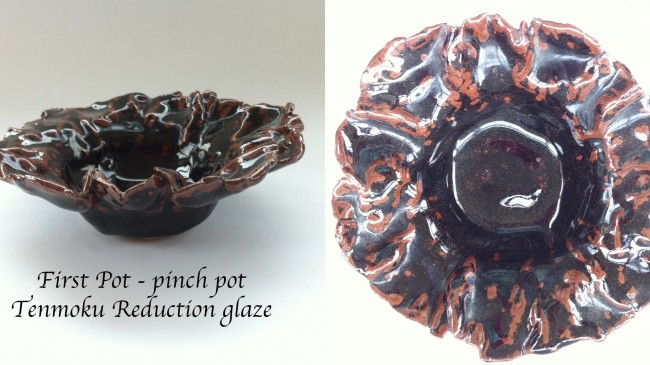 First pot
First pot Example of bowl made at Annes
Example of bowl made at Annes
Fast forward to third year at DOJCA in Dundee - I was already getting a bit of a reputation as a passionate glaze explorer - well there was the opportunity to mix any glaze I wanted and I tested masses, but in third year my technician Paul Spence and I had a informal chat about making In Glaze Reduction Lustre - he used Clay Paste lustre on some of his pieces. He said it was easy - well the theory was but the reality was a lot harder - pre internet and with only Margory Clinton's book to guide me it took quite a few attempts in one of the gas kilns in Dundee to get glimmers of what might be. But, I was hooked not just on clay but making shiny sparkly ceramics.....
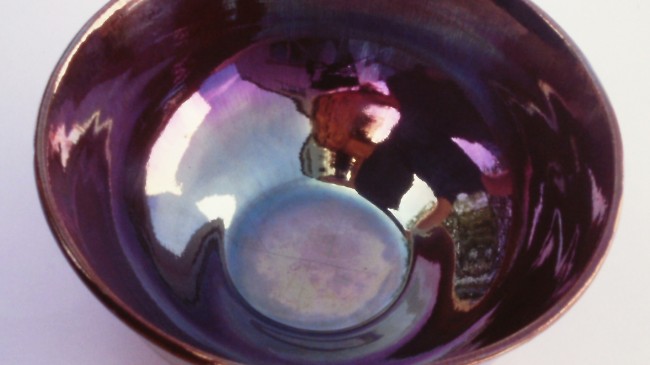 One of my first lustre bowls
One of my first lustre bowls Really early wavy edged bowl
Really early wavy edged bowl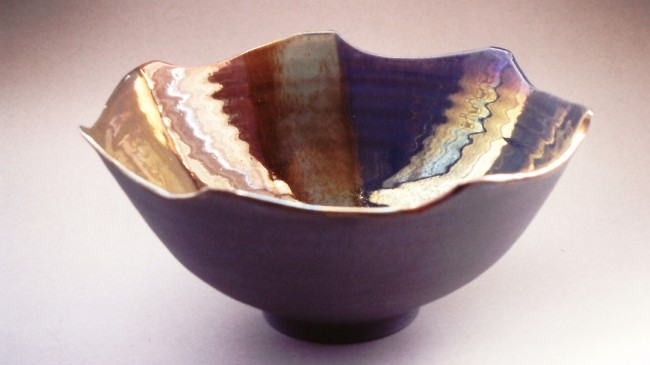 Side view early wavy edged bowl
Side view early wavy edged bowl
All glazes are fascinating especially the ones you create yourself - I now wish I could magic myself back to my Chemistry class at Sexey's Grammar School (yes it really was called that) and ask questions of my teacher but that won't happen so I take meticulous notes and continually try new ideas. It's hard to explain to non potters just how different things look - basically at the raw glaze stage I have a variety of mostly grey looking glazes which are then fired in an electric kiln, changing them again. After they have had their third firing in the gas kiln the lustre magic has happened as the two photos below show
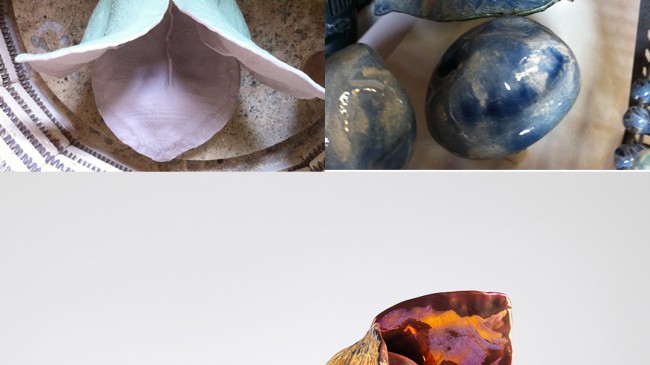 Steps of firing a seed pod
Steps of firing a seed pod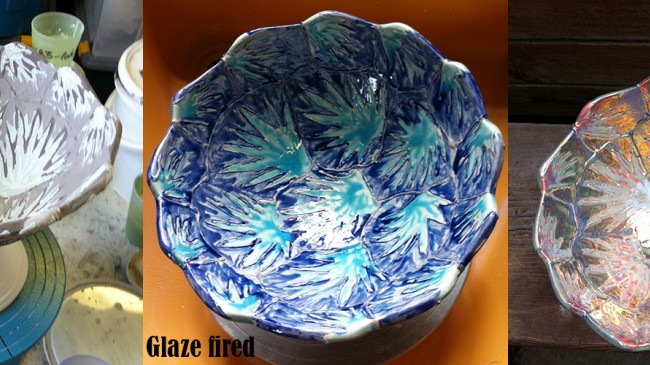 Turtle bowl glazing stages
Turtle bowl glazing stages
I know that I will often fail but the magic is there - the rainbow bowl shown below was from the first batch that turned out like that (I wish I had kept them all - but you have to eat!). I thought I was finally in control but it took me probably another 5 years to be able to reproduce them reasonably regularly and even now the Watergaw effect does not always happen - it's just magic from one glaze!

 First pot
First potFirst pot
 Example of bowl made at Annes
Example of bowl made at AnnesExample of bowl made at Annes
Fast forward to third year at DOJCA in Dundee - I was already getting a bit of a reputation as a passionate glaze explorer - well there was the opportunity to mix any glaze I wanted and I tested masses, but in third year my technician Paul Spence and I had a informal chat about making In Glaze Reduction Lustre - he used Clay Paste lustre on some of his pieces. He said it was easy - well the theory was but the reality was a lot harder - pre internet and with only Margory Clinton's book to guide me it took quite a few attempts in one of the gas kilns in Dundee to get glimmers of what might be. But, I was hooked not just on clay but making shiny sparkly ceramics.....
 One of my first lustre bowls
One of my first lustre bowlsOne of my first lustre bowls
 Really early wavy edged bowl
Really early wavy edged bowlReally early wavy edged bowl
 Side view early wavy edged bowl
Side view early wavy edged bowlSide view early wavy edged bowl
All glazes are fascinating especially the ones you create yourself - I now wish I could magic myself back to my Chemistry class at Sexey's Grammar School (yes it really was called that) and ask questions of my teacher but that won't happen so I take meticulous notes and continually try new ideas. It's hard to explain to non potters just how different things look - basically at the raw glaze stage I have a variety of mostly grey looking glazes which are then fired in an electric kiln, changing them again. After they have had their third firing in the gas kiln the lustre magic has happened as the two photos below show
 Steps of firing a seed pod
Steps of firing a seed podSteps of firing a seed pod
 Turtle bowl glazing stages
Turtle bowl glazing stagesTurtle bowl glazing stages
I know that I will often fail but the magic is there - the rainbow bowl shown below was from the first batch that turned out like that (I wish I had kept them all - but you have to eat!). I thought I was finally in control but it took me probably another 5 years to be able to reproduce them reasonably regularly and even now the Watergaw effect does not always happen - it's just magic from one glaze!

Contact Us
If you would like to know more about what we do and our creations then please contact us. We are always delighted to hear from you.
- Watergaw Ceramics
4 Chapel Street
Whitehills
Banff
AB45 2NB - View Street Map
-
Opening Hours
Monday - Closed
Tue-Sat 10am - 5pm
Sunday - Closed - Wheelchair Accessible







